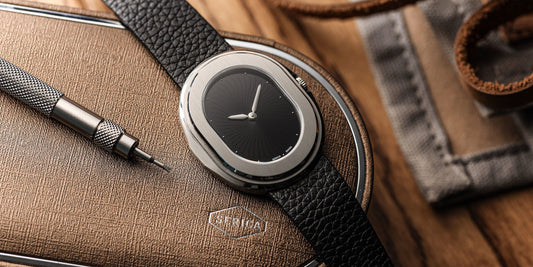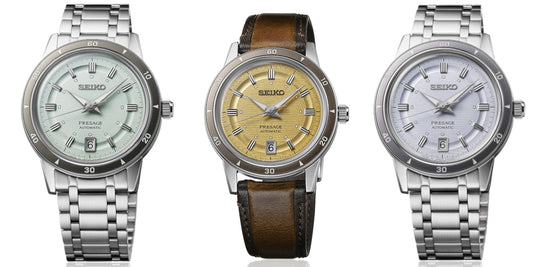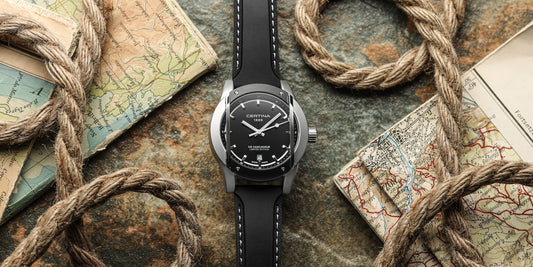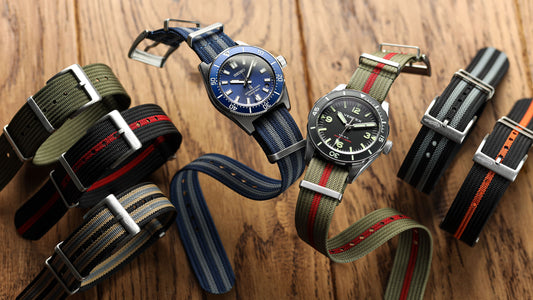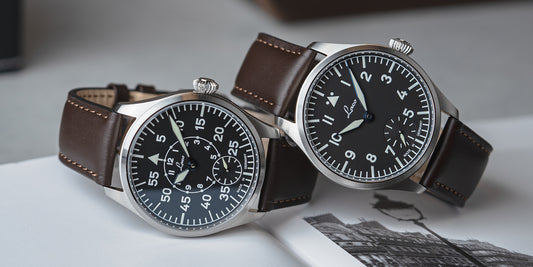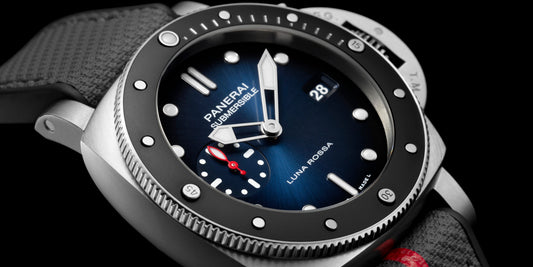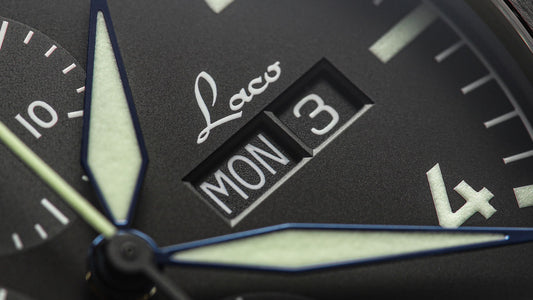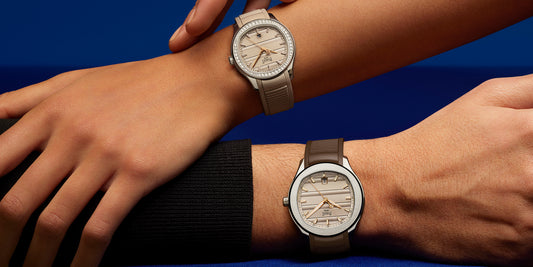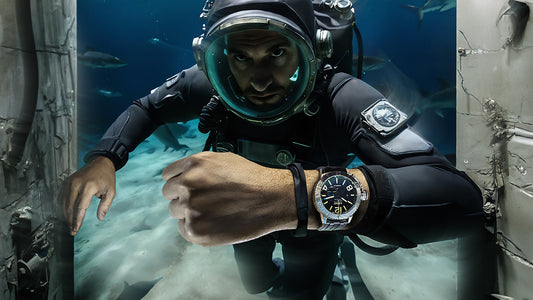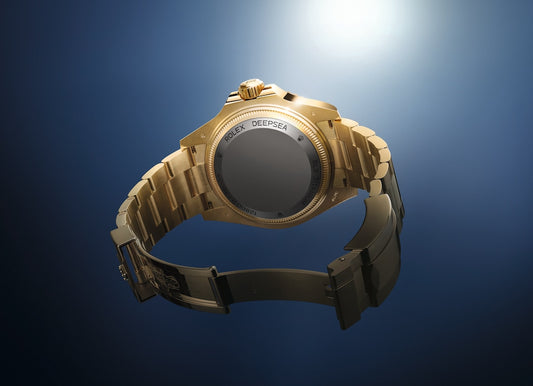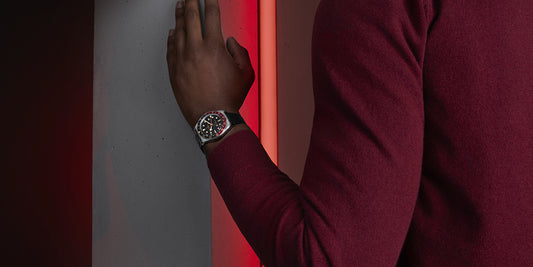It's a great day when you get a Doxa in for review and an even better day when you get two.
Doxa is not a brand we cover very often, and there's no good reason for that because it has a huge following thanks to its superior watches and links to the best-selling author Clive Cussler. To compensate for this, we secured two fantastic watches for hands-on and some super photographs. They were the Doxa Sub300 Carbon and the Sub 200 C-Graph II Caribbean.
Everyone has a quintessential Doxa in their mind, and it's most likely a Sub 300T which is a reinterpretation of the 1968 SUB 300T Conquistador. The watch has been popular for over 50 years primarily because it has successfully retained classic 60s styling yet somehow remained contemporary. It doesn't date (which is no mean feat).
 DOXA Sub 300 Carbon Orange - Credit WatchGecko
DOXA Sub 300 Carbon Orange - Credit WatchGecko
A bit of History
Doxa's journey began in the Jura Mountains of Switzerland with the apprentice watchmaker George Ducommun. He started watching making in 1880, and it soon became apparent he had real skills. He built a reputation for ingenuity and, at the age of 21, opened his own business called George Ducommun Fabric Doxa. Doxa is the Greek word for glory, and this seemed to George a perfect name for the exceptional standard of artistry that he aimed to put into his end product culminating in 1906 with his anti-magnetic doctor winning a gold medal at the world fair in Milan. The company then passed through successive generations.
In 1967, Doxa produced their first purpose-built professional dive watch titled the Sub, designed to appeal to the ever-growing scuba diving market, which was in its infancy as a sport. The Sub was developed in concert with the diving legend Jacques Cousteau, and the model became a benchmark for sub-aquatic watches. Thankfully the Sub exists relatively unchanged today. Although updated for a new demographic of buyers, it is highly recognisable. By 2023 the company has moved beyond the original Ducommun family, but it's still run with the same passion and drive for excellence.
The Sub 300 Carbon

DOXA Sub 300 T - Credit WatchGecko
The Sub 300 T remains the iconic Doxa dive watch; however, the model we selected to look at, while superficially clearly a Doxa, represents the pinnacle of cutting-edge technology and aesthetics. The Sub 300 Carbon retails at £3790, so it is by no means cheap however, it is the first significant change to the Sub range since its inception. The watch remains thoroughly faithful to the original design but uses an advanced lightweight forged carbon to construct the case. The watch is astonishingly light in weight, and a pressure-resistant titanium inner case allows it to retain 300 metres of water resistance.
The sapphire crystal, which protects the vibrant orange dial we had for the test, is hugely doomed, which gives the watch a thoroughly vintage feel, so despite this space-age technology, the watch stays true to the 1960s original. However, the swirl pattern created as part of the manufacturing process on the 42.5mm carbon case is stunning. The material finished to an ultra-smooth standard. The use of this material allows the 300 Carbon to weigh only 45 grams which is a full 40% lighter than its stainless steel version.
The Doxa Carbon is powered by a modified ETA 2824-2. It is a COSC-certified movement with a frequency of 28800 VPH and an apparel survey of 38 hours
So How Does it Wear?

Wrist-shot of DOXA Sub 300 T - Credit WatchGecko
In short, beautifully. There's no question the case construction and price of the 300 Carbon dive watch will not be to everybody's taste; however, when you strap it on, and you can feel virtually nothing, only then does the marvel of this technology really drive home. There is a constant misconception in the watch world that weight translates to quality, and this is simply not true. So often at exhibitions, we see people pick up watches, and weigh them in their hands, and somehow this action translates to a judgement of quality. It is relatively easy to make a beefy steel case; however, it is incredibly hard and innovative to make a 300m capable case that betrays nothing of the brand's aesthetics and is made from the most advanced modern Formula One style material. Doxa has really pulled this off, and for that reason alone really love the Sub 300 carbon.
Sub 200 C-Graph II Caribbean
 DOXA Sub 200 C-Graph II - Credit WatchGecko
DOXA Sub 200 C-Graph II - Credit WatchGecko
As we alluded to at the beginning of the feature, Doxa kindly gave us two watches to look at, the second of which was the Sub 200 C-Graph II Caribbean.
In fairness, you probably would not immediately know this watch is a Doxa because it lacks the distinctive case style we associate with the brand; however, that does not make it unattractive.
The Sub 200 C-Graph II is a dive watch which sports a chronograph complication and still delivers 200-metre water resistance. It comes with a traditional 42mm steel case and offers the same quality you would expect from any model from Doxa.
The watch is billed as a diving chronograph, but the reality is the model is an almost perfect daily wear watch that is wrist friendly whether you choose the FKM rubber strap or the beads of rice steel strap. The C-Graph will look good whether you're diving off a boat in St. Lucia or attending a business meeting in London.
 DOXA Sub 200 C-Graph II - Credit WatchGecko
DOXA Sub 200 C-Graph II - Credit WatchGecko
Once again, Doxa has installed a modified aftermarket movement in the Sellita SW510, which delivers an impressive 56 hours of power reserve.
As Doxa fans will know, the Sub 200 C-Graph II is a reiteration of the original C-Graph, which was a much larger 45mm watch. All of the characteristics you would expect from a Doxa dive watch are retained, and the new watch is fundamentally a new model. The case has been redesigned, the dial has a sunburst play on it, and the bezel has been redesigned. In short, everything has been made more contemporary, slightly reduced in size, and ultimately the result is a hugely wearable watch that is in many ways more practical than the original model.
We deliberately asked for the blue Caribbean model because we really felt it was the most attractive, and when it came out of the box we were not disappointed. In every measurable way, it is a beautiful watch which you could definitely wear every day, on any occasion.
Even though it is reduced in size with a manageable lug-to-lug of 46 millimetres, the watch is still relatively high because, once again, Doxa has smartly retained that trademark high sapphire crystal dome glass making the C-Graph II 16 millimetres high. However, it was probably better to retain this design characteristic to give a commonality with the rest of the portfolio.
So How Does the 200 C-Graph II Wear?

DOXA Sub 200 C-Graph II - Credit WatchGecko
The Sub 200 C-Graph II Caribbean is a definite improvement on the old model and definitely more on-trend with revised colour palettes making the watch universally appealing to both sexes. You could easily imagine a female or male diver wearing this watch in white or blue, which we need to acknowledge because it's not easy to design. The price point of £2850 is reasonable for the model and certainly makes it cheaper than a number of dive chronographs on the market. We especially like some of the more minor technical touches, which show that Doxa has set out to create a high-end tool watch, not just a fashion watch. For example, the way the crown and the pushers are sunk into the case for extra protection.
Conclusion
Having two Doxas to play with and photograph has been a treat. We should see more thanks to the kind people at The Blue Company who look after Doxa's UK business. If there are any Doxas you would particularly like us to review in more detail, please let us know, and we'll try our best to get them in. If you have not considered Doxa as a high-end luxury purchase, think again. The build quality standard we have seen in these two fundamentally different watches is very high, and they can stand shoulder to shoulder very proudly with other Swiss models, which cost a lot more.



